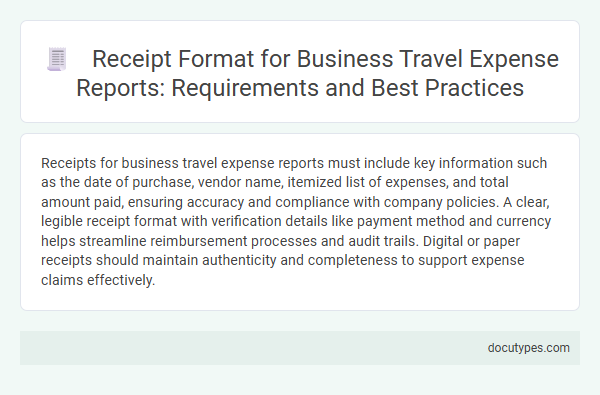Receipts for business travel expense reports must include key information such as the date of purchase, vendor name, itemized list of expenses, and total amount paid, ensuring accuracy and compliance with company policies. A clear, legible receipt format with verification details like payment method and currency helps streamline reimbursement processes and audit trails. Digital or paper receipts should maintain authenticity and completeness to support expense claims effectively.
Introduction to Business Travel Expense Receipts
Receipts play a crucial role in documenting business travel expenses for accurate reporting and reimbursement. Proper receipt formats help ensure compliance with company policies and tax regulations.
Business travel expense receipts must clearly display the date, vendor name, and specific items or services purchased. Receipts should also include the total amount paid and proof of payment method. Maintaining organized and detailed receipts simplifies the expense reporting process and supports audit requirements.
Importance of Proper Receipt Documentation
Proper receipt documentation is crucial for accurate business travel expense reporting, ensuring compliance with company policies and tax regulations. Your ability to provide clear and detailed receipts can simplify reimbursement processes and avoid audits.
- Itemized Receipts - Receipts must list each purchased item separately, showing descriptions and individual costs for transparency.
- Date and Vendor Information - Receipts should include the transaction date and vendor name to verify the expense timing and source.
- Payment Method and Total Amount - Receipts need to display the total charge and payment method to confirm the transaction's authenticity and completeness.
Key Elements of a Business Travel Receipt
A business travel receipt must include key elements such as the date of the transaction, the vendor's name, and a detailed description of the purchased items or services. Essential information also covers the total amount paid, payment method, and clearly visible tax details. These components ensure accurate documentation and compliance with company expense policies for travel reimbursements.
Standard Receipt Format Requirements
A standard receipt format for business travel expense reports must include the vendor's name, date of purchase, and a detailed description of the items or services purchased. It should clearly display the total amount paid, including taxes and any additional fees. A valid receipt must also show proof of payment such as a credit card authorization or cash transaction confirmation to ensure accurate expense verification.
Acceptable Types of Receipts for Expense Reports
Business travel expense reports require receipts that clearly detail the transaction date, vendor name, and amount paid. Acceptable receipt formats include printed paper receipts, electronic receipts, and digital invoices.
Receipts must show itemized charges to ensure accurate expense verification. Credit card statements alone are usually insufficient unless accompanied by a detailed receipt.
Common Mistakes in Receipt Submission
Receipts for business travel expense reports must include clear details such as the date, vendor name, itemized charges, and total amount paid. Proper formatting ensures timely reimbursement and compliance with company policies.
Common mistakes in receipt submission include submitting blurry images or incomplete receipts missing key information. You should always verify that your receipts are legible and contain all required details before submission to avoid delays.
Digital vs. Paper Receipts: Pros and Cons
| Receipt Format | Pros | Cons |
|---|---|---|
| Digital Receipts |
|
|
| Paper Receipts |
|
|
Best Practices for Organizing Travel Receipts
Proper receipt format is crucial for accurate business travel expense reports. Organizing travel receipts efficiently helps streamline reimbursement and auditing processes.
- Include essential details - Ensure each receipt contains the date, vendor name, amount, and payment method.
- Use digital copies - Scan or photograph receipts to maintain legible records and prevent loss.
- Sort by category and date - Arrange receipts by expense type and chronological order for clarity and quick reference.
Your attention to maintaining clear, complete receipts simplifies expense tracking and approval.
Guidelines for Lost or Missing Receipts
What receipt format is required for business travel expense reports? Receipts must clearly show the date, vendor, amount, and business purpose. For lost or missing receipts, a detailed expense affidavit or a company-specific form should be submitted as proof of purchase.
What Receipt Format Is Needed for Business Travel Expense Reports? Infographic

